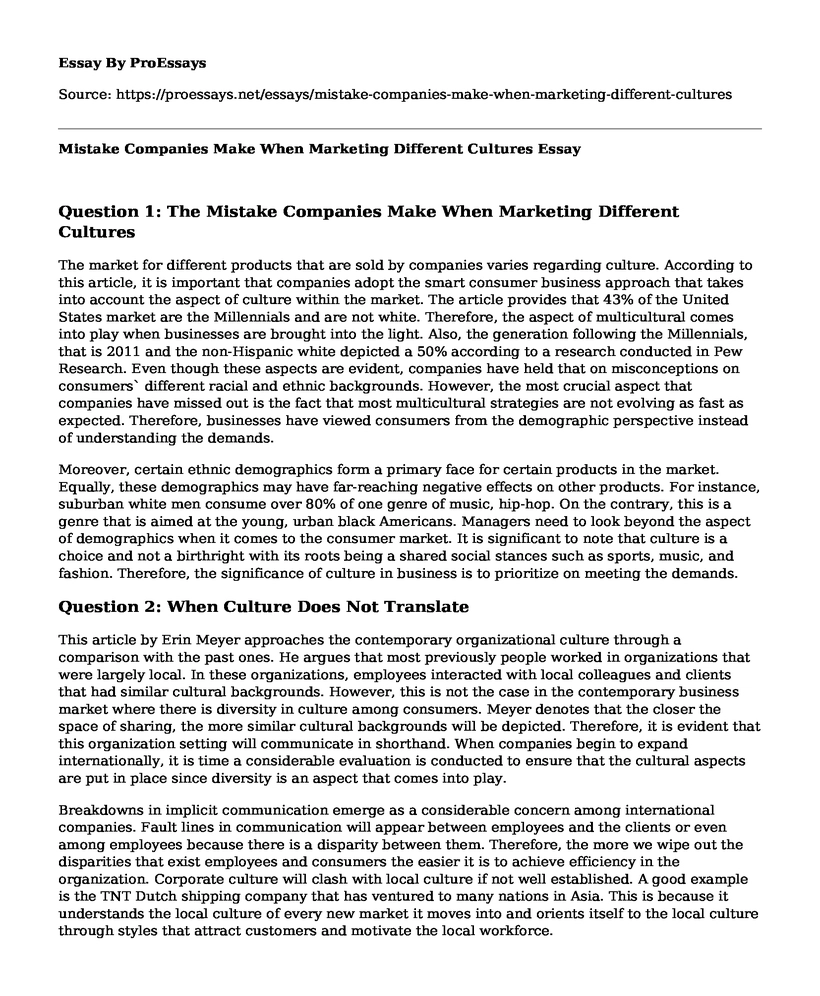Question 1: The Mistake Companies Make When Marketing Different Cultures
The market for different products that are sold by companies varies regarding culture. According to this article, it is important that companies adopt the smart consumer business approach that takes into account the aspect of culture within the market. The article provides that 43% of the United States market are the Millennials and are not white. Therefore, the aspect of multicultural comes into play when businesses are brought into the light. Also, the generation following the Millennials, that is 2011 and the non-Hispanic white depicted a 50% according to a research conducted in Pew Research. Even though these aspects are evident, companies have held that on misconceptions on consumers` different racial and ethnic backgrounds. However, the most crucial aspect that companies have missed out is the fact that most multicultural strategies are not evolving as fast as expected. Therefore, businesses have viewed consumers from the demographic perspective instead of understanding the demands.
Moreover, certain ethnic demographics form a primary face for certain products in the market. Equally, these demographics may have far-reaching negative effects on other products. For instance, suburban white men consume over 80% of one genre of music, hip-hop. On the contrary, this is a genre that is aimed at the young, urban black Americans. Managers need to look beyond the aspect of demographics when it comes to the consumer market. It is significant to note that culture is a choice and not a birthright with its roots being a shared social stances such as sports, music, and fashion. Therefore, the significance of culture in business is to prioritize on meeting the demands.
Question 2: When Culture Does Not Translate
This article by Erin Meyer approaches the contemporary organizational culture through a comparison with the past ones. He argues that most previously people worked in organizations that were largely local. In these organizations, employees interacted with local colleagues and clients that had similar cultural backgrounds. However, this is not the case in the contemporary business market where there is diversity in culture among consumers. Meyer denotes that the closer the space of sharing, the more similar cultural backgrounds will be depicted. Therefore, it is evident that this organization setting will communicate in shorthand. When companies begin to expand internationally, it is time a considerable evaluation is conducted to ensure that the cultural aspects are put in place since diversity is an aspect that comes into play.
Breakdowns in implicit communication emerge as a considerable concern among international companies. Fault lines in communication will appear between employees and the clients or even among employees because there is a disparity between them. Therefore, the more we wipe out the disparities that exist employees and consumers the easier it is to achieve efficiency in the organization. Corporate culture will clash with local culture if not well established. A good example is the TNT Dutch shipping company that has ventured to many nations in Asia. This is because it understands the local culture of every new market it moves into and orients itself to the local culture through styles that attract customers and motivate the local workforce.
Question 3: Case Study
The key issues Levendary Cafe is facing in the China Market include modes of entry into the Chinese Market. For instance, entering into a foreign market requires changing the entire menu while keeping the same look and feel. This is an approach that Levendary Cafe has not enacted in the new market. When this business ventured into the Chinese market, it did not follow the cultural prospects. For instance, each restaurant in the locations that Chen opened brought new menu options on undesirable operating standards. The company ruined its brand although it had developed a strong market reputation in the United States through serving soups, salads, and sandwiches.
Louis Chen has responded to the differences in the Chinese market through providing different products/menu options to her customers. For instance, across different restaurants in various locations in China, Chen has established menu options that define the culture of these individuals. Her strategy has not been effective because the consumers do not have the company recognition since there different products across the country. Mia Foster should approach sticking to specific cultural demands of the Chinese market and ensure they are served with uniqueness. She should advise Chen on the value of brand recognition in a new market.
At the headquarters, there are different changes I would propose. First, a multi-unit franchise restaurant business such as Chen`s restaurant seems to be missing a link between the two cultures that is not being understood by headquarters. There is the organizational culture and the local culture. Also, it would be valuable to renovate the current layout of the stores and invest more from the United States. This would ensure the business can compete effectively in the new market.
Cite this page
Mistake Companies Make When Marketing Different Cultures. (2022, Mar 29). Retrieved from https://proessays.net/essays/mistake-companies-make-when-marketing-different-cultures
If you are the original author of this essay and no longer wish to have it published on the ProEssays website, please click below to request its removal:
- The Hyundai Approach to Selling Cars
- Konecranes: Assignment Sample
- Publix Super Markets Case Analysis
- Managing a Global Supply Chain: Apple Inc - Essay Sample
- Argumentative Essay on Consumerism
- Essay Sample on 3 Essential Corporate Policies: Cultivating a Culture of Inclusion
- Essay Example on Tech Advances Making Smartphone Shopping Easier and More Fun







